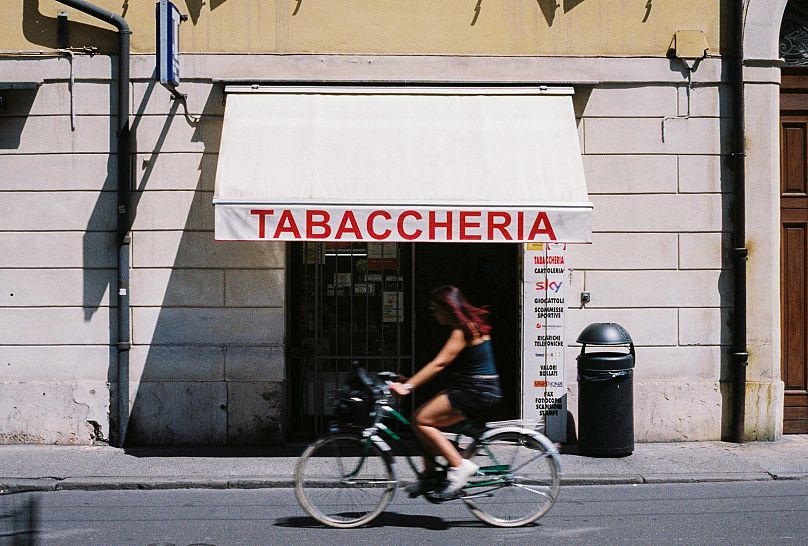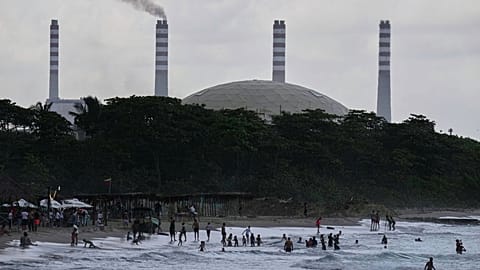Italy’s industrial heartland has a long way to go to reach the EU’s goal of zero air pollution.
Sitting at her kitchen table in Modena in Italy’s Emilia Romagna province, Valentina goes through the medical history of her and her husband’s family.
Cancer has been common on both sides, with Valentina (54) beating breast cancer several years ago and her husband Andrea (55) in recent remission for bone marrow cancer.
“It would be probable that this situation is exacerbated by the pollution,” Valentina tells Euronews Green.
The Po Valley where the couple live is one of the most polluted places in Europe in terms of air quality. Major cities such as Milan in Lombardy and Turin in Piedmont suffer heavy pollutants from traffic and indoor heating from wood burning, as well as industries like farming, engineering and ceramics.
“Our family is touched by this situation. Probably if we lived in another county without this industrial distribution, it might be different.”
The links between air pollution and poor health
Nitrous dioxide, ozone and inhalable particulate matter (PM) - especially PM10 and PM2.5 - are among the most harmful products in the atmosphere. They are causing serious health risks to the more than 16 million Italians living in the Po Valley.
According to datasets released by the European Environment Agency (EEA), Italy had 11,282 premature deaths due to nitrogen dioxide exposure in 2021, the highest in Europe.
Cancer is also the second leading cause of death in the country, with lung cancer accounting for the highest number of deaths for men and women.
Even though the north is economically richer, better in diet, has fewer smokers and less overweight people than the country’s south, the Po region shows a higher mortality rate for cancer, a report from the University of Bologna highlighted.
“All the studies state in a clear unequivocal way that there is a direct connection between living in a highly polluted area and high risks of health degeneration,” says Professor Signorelli, president of the Association of Schools of Public Health in the European Region (ASPHER).
Urban centres are particularly at risk, with the city of Cremona in the Lombardy region having the fourth highest concentration of PM2.5 in Europe according to the EEA.
Cities such as Verona, Padova and Vicenza also showed an increase in PM2.5 between 2018 and 2022, a report by the European Data Journalism Network found.
An uphill struggle for the regions of the Po
The geography that allowed Italy to industrialise its north is the same that has caused the degradation in its air quality. Its plainlands provide 35 per cent of the country’s agricultural production, and are home to factories producing roof tiles and bricks.
Surrounded by the Alps to its north and the Apennine Mountain range to its south, atmospheric pollutants get trapped in the valley. An unhealthy concentration builds up in its densely populated cities.
“The Po Valley is characterised by high levels of urbanisation with meteorological conditions that are generally unfavourable to the pollutants’ dispersion,” explains Secondo Barbero, general director of Regional Agency for Environmental Protection (ARPA) of Piedmont.
This is especially true during the winter when there is little wind and cooler, more dense air moves slower, trapping pollutants in the atmosphere. This increased stagnation also means that people are exposed to these pollutants for a longer time than in summer.
“So, reducing pollution levels below the limits set by EU legislation requires in the Po Valley a much greater effort than in other areas,” says Barbero.
There has been some improvement in the last 20 years, however. A shift away from fossil fuels in transport and home heating systems has seen a slight drop in pollutants in the valley’s atmosphere.
2023 even saw the amount of PM10, PM2.5 and nitrogen dioxide fall within nationally recommended limits, making it one of best years in terms of minimised levels of PM10 and PM2.5 in the atmosphere.
‘A better information campaign is needed’
Like many, Beatrice Bos wants to see change. A team leader of the organisation Our Youth 4 Climate Milano, she educates young people on environmental issues across Milan and Lombardy.
“Milan is a city with great pollution problems, but no one is truly aware of the critical state of it, especially compared to other zones in Europe,” she explains.
The importance of the region cannot be understated. With one-third of Italy’s population and nearly half of the GDP generated there, it's little wonder that national institutions and private companies are not eager to highlight how harmful this productivity can be for the populace of the Po.
But climate action demands change. According to a report by a commission of Italy’s Ministry of Sustainable Infrastructure and Mobility, an additional investment of 16 billion euros is needed to cut emissions by 55 per cent by 2030 and reach net zero by 2050.
“Certainly, the majority of the population is aware of the dangers of this pollution,” says Barbara Meggetto, President of Legambiente Lombardia branch.
Legambiente is the largest environmental non-profit in Italy, funding research and promoting more ambitious environmental policies within regional and national government.
“Institutional communication has always avoided confronting citizens with the causes, precisely to avoid affecting purchasing behaviour and mobility habits,” she claims, “effectively providing a sort of institutional alibi with respect to the need to develop more sustainable mobility of people and goods.”
Secretariat of Legambiente’s Emilia Romagna branch, Paola Fagioli, agreed that “a better information campaign is needed.”
Following the passing of the Ambient Air Quality Directive in February by the European Environmental Bureau, the EU now aims to reduce air pollution as much as possible, to net zero by 2050.
Italy’s Po Valley is fighting against its geological, meteorological, political, and economic constraints to get there.
In Modena, Valentina kisses Andrea who has been working as an electrical engineer for most of his life and has recently come out of two years of hospital visits for his cancer.
“It’s difficult to demonstrate the connection between pollution and our cancer. If they demonstrate this connection they would have to close down a lot of the area,” she says.
Valentina shrugs with a half smile, “There’s not enough research.”



















